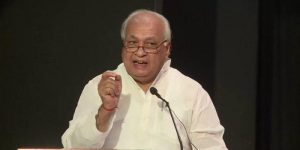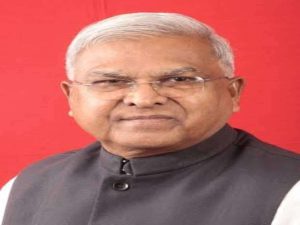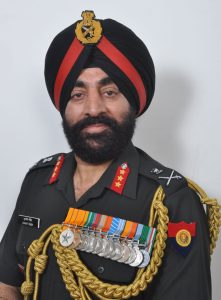
Governors of States of India 2023: As per Article 154 of the Constitution of India, the Governor of a State holds the position of the constitutional head. The Governor is appointed by the President of the country for a term of five years. The Governor serves as the head of the state government and is responsible for the execution of executive decisions in the state under their name. However, it is important to note that the Governor does not possess unilateral decision-making authority. Instead, they must consult and collaborate with the elected council of members led by the Chief Minister of the state.
The responsibilities of a state governor bear similarities to those of the President of the country. Just as the President oversees the entire nation and generally seeks advice from the cabinet of ministers led by the Prime Minister in the central government, the Governor performs a similar role on a state level by seeking inputs and ideas from the state government. This collaborative approach ensures effective governance and facilitates a harmonious relationship between the state government and the constitutional head, the Governor.
This article provides an informative list of Governors of States of India and Union Territories, along with their pictures, essential for students preparing for competitive exams like UPSC, SBI PO, SSC, banking, etc. Additionally, it covers details about the selection process and powers of Governors in India.
Powers vested in the Governor are substantial and span executive, legislative, and judicial domains. In the executive sphere, the Governor appoints the Chief Minister and other ministers. The Governor also holds the authority to grant assent to bills passed by the state legislature and possesses the power to pardon or reduce sentences.
In the legislative realm, the Governor plays a crucial role in summoning and proroguing the state legislature, as well as delivering addresses to the legislative house. Additionally, the Governor exercises judicial powers, including the authority to grant pardons, reprieves, and suspensions of sentences.
The Governor is a constitutional head and a vital part of India’s federal system of governance. Appointed by the President of India, the Governor serves as the representative of the Union Government in each state and Union Territory. The office of the Governor is established by Article 153 of the Indian Constitution, and their powers and functions are outlined in Articles 155 to 159. For the benefit of aspirants preparing for various competitive exams, here is the Governors of India List.
| List of Governors of India of all states with pictures | |||
| S.I. No. | States | Governor | Pictures |
| 1 | Andhra Pradesh | S. Abdul Nazeer |  |
| 2 | Arunachal Pradesh | Lt. General Kaiwalya Trivikram Parnaik |  |
| 3 | Assam | Gulab Chand Kataria |  |
| 4 | Bihar | Rajendra Vishwanath Arlekar |  |
| 5 | Chhattisgarh | Justice (Retd) Biswa Bhusan Harichandan |  |
| 6 | Goa | P.S. Sreedharan Pillai |  |
| 7 | Gujarat | Acharya Devvrat |  |
| 8 | Haryana | Bandaru Dattatreya |  |
| 9 | Himachal Pradesh | Shiv Pratap Shukla |  |
| 10 | Jharkhand | C.P. Radhakrishnan |  |
| 11 | Karnataka | Thawar Chand Gehlot |  |
| 12 | Kerala | Arif Mohammed Khan |  |
| 13 | Madhya Pradesh | Mangubhai Chhaganbhai Patel |  |
| 14 | Maharashtra | Ramesh Bais |  |
| 15 | Manipur | Anusuiya Uikey |  |
| 16 | Meghalaya | Phagu Chauhan |  |
| 17 | Mizoram | Dr. Hari Babu Kambhampati |  |
| 18 | Nagaland | Shri La. Ganesan |  |
| 19 | Odisha | Prof. Ganeshi Lal Mathur |  |
| 20 | Punjab | Shri Banwarilal Purohit |  |
| 21 | Rajasthan | Kalraj Mishra |  |
| 22 | Sikkim | Lakshman Prasad Acharya |  |
| 23 | Tamil Nadu | R.N. Ravi |  |
| 24 | Telangana | Dr. Tamilisai Soundararajan |  |
| 25 | Tripura | Satyadeo Narayan Arya |  |
| 26 | Uttar Pradesh | Anandiben Patel |  |
| 27 | Uttarakhand | Gurmit Singh |  |
| 28 | West Bengal | Dr CV Ananda Bose |  |
Also Read, Chief Ministers of India 2023
The primary duty of the governor is to uphold, protect, and defend the constitution and the laws, as prescribed in their oath of office under Article 159 of the Indian Constitution, while overseeing the administration of state affairs. All actions, recommendations, and supervisory powers (such as Article 167c, Article 200, Article 213, Article 355, etc.) exercised by the governor over the executive and legislative entities of a state are aimed at ensuring the implementation of constitutional provisions.
Unlike the President of India, the governor does not possess military or diplomatic powers. However, they wield legislative, executive, and judicial powers that are akin to those of the President.
A governor’s powers can be categorized as follows:
1. Executive Powers: One of the primary functions of the Governor is to act as the Chief Executive of the state. The Governor appoints the Chief Minister and, on the Chief Minister’s advice, appoints other members of the Council of Ministers. The Governor also has the authority to dismiss the Council of Ministers if they lose the confidence of the State Assembly or fail to prove a majority in a floor test.
2. Legislative Powers: The Governor plays a crucial role in the functioning of the state legislature. They summon and prorogue the State Assembly and, at the beginning of the legislative session, address the members with the Governor’s Address, outlining the government’s policies and programs.
3. Judicial Powers: The Governor exercises certain judicial powers, including the power to pardon, grant reprieves, and suspend or commute sentences of individuals convicted of offenses under state laws.
4. Discretionary Powers: While the Governor primarily acts on the advice of the Council of Ministers, there are certain situations where they can exercise discretion. For instance, if no party has a clear majority in the State Assembly, the Governor may use their discretion to invite the leader of the single largest party or a coalition with adequate support to form the government.
5. Emergency Powers: During a constitutional crisis or breakdown of law and order in a state, the Governor has the power to impose President’s Rule, where the President of India takes over the governance of the state directly, and the Council of Ministers is dismissed.
6. Ceremonial Role: Apart from their constitutional duties, the Governor also participates in various ceremonial functions and represents the state on important occasions.
The Union Territories (UTs) in India are distinct administrative divisions that are directly governed by the central government. Unlike states, they have a Lieutenant Governor (LG) appointed by the President of India, who serves as the chief executive head and representative of the President in the UT. The office of the Lieutenant Governor is established by Article 239 of the Indian Constitution, and their powers and functions are defined in Articles 239 to 241.
|
List of Governors of Union Territories of India with Pictures |
|||
| S.I. No. | Union Territory | Governors | Pictures |
| 1 | Andaman & Nicobar | Admiral (Retd.) Shri. Devendra Kumar Joshi (Lieutenant Governor) |  |
| 2 | Chandigarh | Shri Banwarilal Purohit (Administrator) |  |
| 3 | Dadra and Nagar Haveli and Daman and Diu | Shri Praful Patel (Administrator) |  |
| 4 | Delhi | Vinay Kumar Saxena (Lieutenant Governor) |  |
| 5 | Jammu and Kashmir | Shri Manoj Sinha (Lieutenant Governor) |  |
| 6 | Lakshadweep | Shri Praful Patel (Administrator) |  |
| 7 | Puducherry | Dr. Tamilisai Soundararajan |  |
| 8 | Ladakh | Brig (Dr) B D Mishra (Retd) |  |
It’s important to note that while the Lieutenant Governor holds significant executive powers, they must exercise these powers in accordance with the provisions of the Constitution and the aid and advice of the Council of Ministers in Union Territories with elected legislative assemblies. This ensures a harmonious working relationship between the central government and the Union Territory’s elected representatives while maintaining administrative efficiency and adherence to democratic principles.
Administrative Authority: The Lieutenant Governor is the highest-ranking official in a Union Territory and exercises executive authority. They are responsible for the administration of the UT and oversee various government departments.
Relationship with the Central Government: The Lieutenant Governor serves as a crucial link between the Union Territory’s government and the central government. They communicate the UT’s requirements, proposals, and issues to the central authorities and coordinate with ministries for implementing various schemes and projects.
Appointment of Chief Minister and Council of Ministers: In Union Territories that have elected legislative bodies, the Lieutenant Governor appoints the Chief Minister and the Council of Ministers on the advice of the elected Chief Minister. However, the LG can use their discretion in specific cases where the situation warrants it.
Legislative Powers: In Union Territories with legislative assemblies, the Lieutenant Governor summons and prorogues the sessions of the legislative assembly. They also deliver the Lieutenant Governor’s Address at the beginning of each legislative session, outlining the government’s policies and priorities.
Discretionary Powers: The Lieutenant Governor has certain discretionary powers, particularly in matters where the UT’s administration and the central government’s interests may differ. In such situations, they can use their discretion to take decisions in the best interest of the Union Territory.
Judicial Powers: The Lieutenant Governor exercises judicial powers and can grant pardons, reprieves, and suspend or commute sentences of individuals convicted of offenses under UT laws.
President’s Rule: In exceptional circumstances, the President of India can impose President’s Rule in a Union Territory on the recommendation of the Lieutenant Governor. This allows the President to directly govern the UT and dismiss the Council of Ministers.
Coordinating with Central Agencies: The Lieutenant Governor collaborates with various central agencies and departments to implement centrally-sponsored schemes, development projects, and initiatives in the Union Territory.
Ceremonial Role: Similar to Governors of States, the Lieutenant Governor also participates in various ceremonial functions, and state events, and represents the Union Territory on important occasions.
Key Points about Governor/Lieutenant Governor/Administrator in India are mentioned below. These points are relevant and essential for candidates preparing for various Government exams, particularly in the General Awareness section. Understanding the role and responsibilities of Governors, Lieutenant Governors, and Administrators in India is crucial for a well-rounded knowledge of the country’s political structure.
The first state governors of each Indian state were responsible for establishing and implementing governance structures in their respective regions. They played a crucial role in shaping the administrative systems and setting the groundwork for future developments in the states. Over time, their contributions have paved the way for the growth and progress of the states as integral parts of India’s diverse and vibrant political landscape. Below is a list of all the state wise list of first governors of India.
|
List of First State Governors in India |
|
| State | First State Governor |
| Andhra Pradesh | Chandulal Madhavlal Trivedi |
| Arunachal Pradesh | Bhishma Narain Singh |
| Assam | Sir Muhammad Saleh Akbar Hydari |
| Bihar | Jairamdas Daulatram |
| Chhattisgarh | D.N. Sahay |
| Goa | Major General K.P. Candeth |
| Gujarat | Mehdi Nawaz Jung |
| Haryana | Shri Dharma Vira |
| Himachal Pradesh | S. Chakravarti |
| Jharkhand | Prabhat Kumar |
| Karnataka | Jayachamarajendra Wadiyar |
| Kerala | Burgula Ramakrishna Rao |
| Madhya Pradesh | Dr. Pattahbhi Sitaramayya |
| Maharashtra | Raja Sir Maharaj Singh |
| Manipur | B. K. Nehru |
| Meghalaya | Braj Kumar Nehru |
| Mizoram | S.P. Mukherjee |
| Nagaland | Vishnu Sahay |
| Odisha | Dr. Kailash Nath Katju |
| Punjab | Chandulal Madhavlal Trivedi |
| Rajasthan | Raj Pramukh Sawai Sh. Mansingh |
| Sikkim | B.B. Lal |
| Tamil Nadu | Maharaja Shri Sir Krishna Kumarsingji Bhavsingji |
| Telangana | E.S.L. Narasimhan |
| Tripura | B.K. Nehru |
| Uttar Pradesh | Sarojini Naidu |
| Uttarakhand | Surjit Singh Barnala |
| West Bengal | Chakravarthi Rajagopalachari |
There are 28 State Governors in India.
The first Governor-General of India was Warren Hastings. He served as the Governor-General from 1774 to 1785. The title "Governor-General" was later changed to "Viceroy of India," and the first Viceroy was Lord Canning, who took office in 1858.
The first woman to become a Governor of an Indian state was Sarojini Naidu. She was appointed as the Governor of the United Provinces (present-day Uttar Pradesh) in 1947.
The youngest Governor-General of India was Lord Dalhousie (James Andrew Broun-Ramsay). He assumed office at the age of 36 in 1848 and served as the Governor-General until 1856.
The minimum age to become a Governor of India is 35 years, as per Article 157 of the Indian Constitution.

<div class="new-fform">
</div>